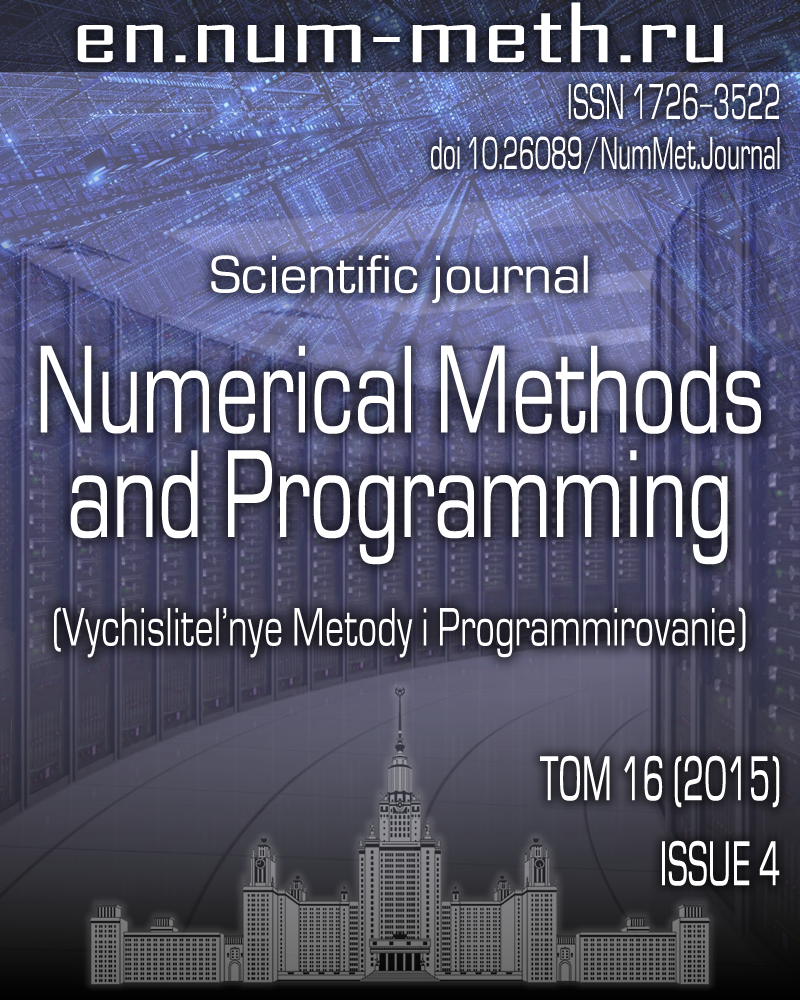DOI: https://doi.org/10.26089/NumMet.v16r456
Efficiency study of computation parallelization for viscous incompressible flow simulation on computing systems with shared memory by the LS-STAG method
Keywords:
Abstract
The LS-STAG_ext parallel software package is developed for viscous incompressible flow simulation by the LS-STAG immersed boundary method and its modifications. This package allows one to simulate a flow around moving airfoils of arbitrary shape or around airfoil systems with one or two degrees of freedom. The LS-STAG_ext package supports Intel (R) Cilk (TM) Plus, Intel (R) Threading Building Blocks, and OpenMP parallel programming technologies. The efficiency comparison of parallel algorithms implemented in the LS-STAG_ext package LS-STAG_ext with similar software tools implemented in Intel (R) Math Kernel Library is discussed. In addition, the implementation features of the FGMRES method for solving systems of linear algebraic equations are described.
Published
Issue
Section
References
- R. Mittal and G. Iaccarino, “Immersed Boundary Methods,”Annu. Rev. Fluid Mech. 37, 239–261 (2005).
- Y. Cheny and O. Botella, “The LS-STAG Method: A New Immersed Boundary/Level-Set Method for the Computation of Incompressible Viscous Flows in Complex Moving Geometries with Good Conservation Properties,” J. Comput. Phys. 229 (4), 1043–1076 (2010).
- S. Osher and R. Fedkiw, Level Set Methods and Dynamic Implicit Surfaces (Springer, New York, 2003).
- V. V. Puzikova and I. K. Marchevsky, “Extension of the LS-STAG Immersed Boundary Method for RANS-Based Turbulence Models and Its Application for Numerical Simulation in Coupled Hydroelastic Problems,” in Proc. 6th Int. Conf. on Coupled Problems in Science and Engineering, Venice, Italy, May 18–20, 2015 (Int. Center for Numer. Methods in Engineering, Barcelona, 2015), pp. 532–543.
- V. V. Puzikova, “On Generalization of the LS-STAG Immersed Boundary Method for Large Eddy Simulation and Detached Eddy Simulation,” in Advanced Problems in Mechanics International Summer School-Conference (Inst. for Problems in Mechanical Engineering, St.-Petersburg, 2015), pp. 411–417.
- V. V. Puzikova and I. K. Marchevsky, “Application of the LS-STAG Immersed Boundary Method for Numerical Simulation in Coupled Aeroelastic Problems,” in Proc. 11th World Congress on Computational Mechanics, 5th European Conference on Computational Mechanics, 6th European Conference on Computational Fluid Dynamics, Barcelona, Spain, July 20–25, 2014 (Int. Center for Numer. Methods in Engineering, Barcelona, 2014), pp. 1995–2006.
- Intel(R) Cilk(TM) Plus [Electronic resource]. https://software.intel.com/ru-ru/node/522579. Cited December 3, 2015.
- J. Reinders, Intel Threading Building Blocks: Outfitting C++ for Multi-Core Processor Parallelism (O’Reilly, Sebastopol, 2007).
- IntelR© Math Kernel Library Documentation [Electronic resource]. https://software.intel.com/en-us/articles/intel-math-kernel-library-documentation. Cited December 3, 2015.
- V. V. Puzikova, “Construction of the Level Function for aProfile of Arbitrary Shape by the LS-STAG Method when Modeling of Flow about this Profile,” Vestn. Bauman Mosk. Tekh. Univ., Ser.: Natural Sci., No. 2, 163–173 (2012).
- H. A. van der Vorst, “Bi-CGSTAB: A Fast and Smoothly Converging Variant of Bi-CG for Solution of Nonsymmetric Linear Systems,” SIAM J. Sci. Stat. Comp. 13 (2), 631–644 (1992).
- M. Yu. Balandin and E. P. Shurina, Methods for Solving Systems of Linear Algebraic Equations of High Dimension (Novosibirsk Tekh. Univ., Novosibirsk, 2000) [in Russian].
- P. Wesseling, An Introduction to Multigrid Methods (Willey, Chichester, 1991).
- O. Schenk and K. Gärtner, “Solving Unsymmetric Sparse Systems of Linear Equations with PARDISO,” Future Gener. Comput. Syst. 20 (3), 475–487 (2004).
- Y. Saad, Iterative Methods for Sparse Linear Systems (PWS Publ., New York, 1996).


